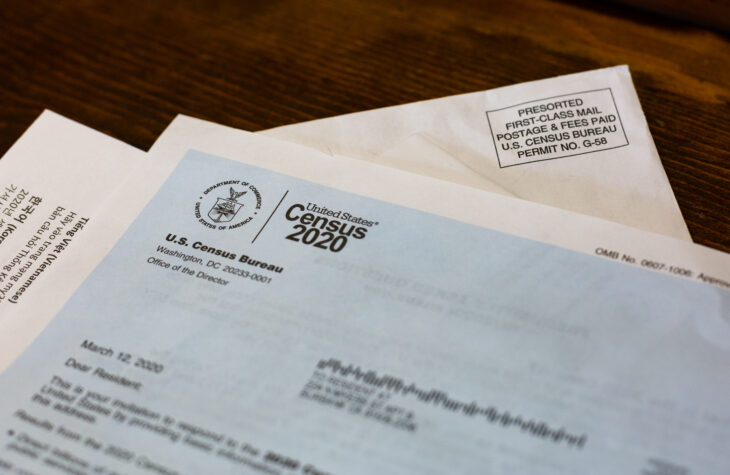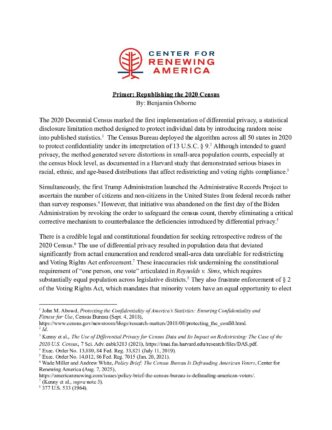
Primer: Republishing the 2020 Census
The 2020 Decennial Census marked the first implementation of differential privacy, a statistical disclosure limitation method designed to protect individual data by introducing random noise into published statistics.1 The Census Bureau deployed the algorithm across all 50 states in 2020 to protect confidentiality under its interpretation of 13 U.S.C. § 9.2 Although intended to guard privacy, the method generated severe distortions in small-area population counts, especially at the census block level, as documented in a Harvard study that demonstrated serious biases in racial, ethnic, and age-based distributions that affect redistricting and voting rights compliance.3
Simultaneously, the first Trump Administration launched the Administrative Records Project to ascertain the number of citizens and non-citizens in the United States from federal records rather than survey responses.4 However, that initiative was abandoned on the first day of the Biden Administration by revoking the order to safeguard the census count, thereby eliminating a critical corrective mechanism to counterbalance the deficiencies introduced by differential privacy.5
There is a credible legal and constitutional foundation for seeking retrospective redress of the 2020 Census.6 The use of differential privacy resulted in population data that deviated significantly from actual enumeration and rendered small-area data unreliable for redistricting and Voting Rights Act enforcement.7 These inaccuracies risk undermining the constitutional requirement of “one person, one vote” articulated in Reynolds v. Sims, which requires substantially equal population across legislative districts.8 They also frustrate enforcement of § 2 of the Voting Rights Act, which mandates that minority voters have an equal opportunity to elect representatives of their choice, an obligation heavily dependent on accurate population data.9 Further, the use of differential privacy eliminated any meaningful redress under the Count Question Resolution program by obscuring whether published errors reflect actual enumeration mistakes or deliberate algorithmic noise.10 Because the algorithm is confidential, jurisdictions cannot verify or challenge their population data without compromising the privacy framework itself, effectively foreclosing attempts for correction.
The Biden Administration’s decision to rescind EO 13880 eliminated the federal government’s ability to use existing administrative records like data from the Social Security Administration, Department of Homeland Security, and IRS to improve the accuracy of citizenship counts.11 The rescission of this order was discretionary and not statutorily compelled, and the current Administration could reinstate it.
The Constitution requires a census to be made “within every subsequent Term of ten Years, in such Manner as they shall by Law direct.”12 This forms the constitutional basis for the decennial census as a floor—required at least once every ten years—not a ceiling that prohibits additional enumerations.
On August 7, 2025, President Trump directed the Department of Commerce to immediately begin work on a new, correct census based on modern-day figures, including information gained from the 2024 Presidential election and excluding illegal aliens.13
I. Legal Roadmap
The Constitution mandates an “actual Enumeration” of the U.S. population within every ten years for the purpose of congressional apportionment.14 While Congress delegates census administration to the Secretary of Commerce and the Bureau of the Census, such discretion must be exercised in a way that ensures accuracy and fairness.15 Although the Supreme Court in Dep’t of Commerce v. New York acknowledged the Secretary of Commerce’s broad discretion in administering the decennial census under the Census Act, it also reaffirmed that such decisions are subject to judicial review under the Administrative Procedure Act (APA).16 The Court held that the APA’s presumption of reviewability applied, and it invalidated the Secretary’s decision to reinstate a citizenship question as arbitrary and capricious because the rationale given was pretextual and not the agency’s actual reasoning.17 The Court has emphasized the census’s critical role in American governance, stating that it is “a linchpin of the federal statistical system by collecting data on the characteristics of individuals, households, and housing units throughout the country.”18 Furthermore, lower courts have long held that severe inaccuracies or systemic errors in census methodology may warrant equitable relief if they violate constitutional principles.19
In Carey v. Klutznick, the Second Circuit affirmed that federal courts may issue equitable relief when census procedures produce systemic inaccuracies that undermine the constitutional requirement of an actual enumeration.20 The court held that significant undercounts violating representational and funding equity could justify judicial intervention, even before final certification.21 This directly parallels concerns with the 2020 Census, where the Census Bureau’s use of differential privacy introduced statistically measurable distortions in population counts, especially among small, rural, and minority communities, raising serious constitutional and statutory concerns under Article I, Section 2. If shown to have materially affected apportionment or funding, such defects may warrant retrospective correction under Carey’s framework.
In California v. Ross, the court held that the Secretary’s decision to add a citizenship question to the 2020 Census violated the APA, finding the rationale pretextual and the decision arbitrary and capricious.22 The court emphasized that census methodology is reviewable when it undermines the constitutional mandate of an actual enumeration.23 The differential privacy algorithm introduced systemic distortions without adequate justification, compromising data integrity for apportionment and redistricting. Ross thus affirms that census methods causing material inaccuracy—whether political or technical—are constitutionally suspect and subject to judicial remedy.
In Trump v. New York, the Supreme Court reviewed the Trump Administration’s attempt to exclude illegal immigrants from the 2020 census apportionment count and did not decide the legality of excluding illegal aliens; instead, it dismissed the challenge as unripe, noting significant uncertainties in its implementation.24 Crucially, the Court emphasized that any apportionment policy must still satisfy the Constitution’s requirement of an “actual Enumeration” of persons in each state.25 In practical terms, this means the government cannot rely on mere estimates or sampling to exclude illegal aliens – it needs a feasible, data-driven method to identify and count (or exclude) persons on an individualized basis. The Court observed that it appeared somewhat impractical at that time to exclude all 10+ million illegal aliens, given the lack of concrete data, and it expressed “no view on the merits” of the legality of such exclusion absent a workable plan.26
In Department of Commerce v. New York, the Supreme Court blocked the addition of a census citizenship question, not because asking about citizenship is inherently forbidden, but because the Commerce Secretary’s APA process was flawed.27 The Court found Secretary Wilbur Ross’s rationale (enforcing the Voting Rights Act) to be pretextual – contrived and not the real reason for adding the question.28 This decision underscores that agency action must be transparent and justified by evidence, especially for something as consequential as the census.29 The Court held that while agencies have policy discretion, their decisions will be set aside if the given rationale is a distraction or more of a distraction than an explanation. In short, misusing the process or hiding true motives invites judicial invalidation.30
A. No Categorical Prohibition by SCOTUS.
Notably, the Supreme Court in Trump v. New York did not hold that excluding illegal aliens is substantively illegal – it avoided the question. The dissenting justices argued the exclusion would violate the Constitution’s text and historical practice of counting “the whole number of persons in each State,” regardless of status. But the majority left the door open, indicating a future administration might attempt a similar policy if it addresses the procedural and factual hurdles. In other words, there is no definitive ruling forbidding the exclusion of illegal aliens from the census count; there is only a clear warning that courts will require strict adherence to constitutional and statutory constraints.
B. “Actual Enumeration” Requirement.
Any new census or republished adjusted count must be designed as an actual person-by-person count, not a guess or broad statistical extrapolation, as we saw in 2020 with differential privacy. The Constitution in Art. I §2 and Amend. XIV mandates an “actual Enumeration” every ten years. In Trump v. New York, the government conceded that compliance with the actual enumeration requirement is mandatory, meaning “conjectural estimates” or sweeping exclusions without data are impermissible. Federal law prohibits the use of sampling for apportionment.31 Bottom line: a recount must tabulate individuals through reliable methods, ensuring each person is accounted for by name or identifier, rather than using probabilities, skewed algorithms, or assumptions.
II. Applying the Roadmap: Republishing a Lawful Census with Correct Data
Using the Supreme Court’s guidance as a roadmap, the President can pursue an adjusted census in a way that can withstand litigation.
A. Establish Clear Legal Authority.
First, the administration should ground the republishing of the 2020 census in clear legal authority. While the Constitution mandates a census within every ten years, it does not forbid additional counts or data collections.
B. Comply with the APA.
The Department of Commerce must scrupulously follow the Administrative Procedure Act steps to avoid the fate of the 2019 citizenship question and include a solid administrative record showing the need for a republished census. The showing should reveal how counting illegal aliens affects apportionment under current practice and strips away the voting rights of citizens by reapportioning congressional representation away from them.
C. Equal Protection Claims.
Opponents would likely claim the President is targeting illegal aliens, motivated by discriminatory intent, and violating the Fifth and Fourteenth amendments. But the goal of republishing the census with correct and factual figures is that the representative government should reflect the consent of the governed, who are the citizens of this country.
D. Constitutional Exigency: Prompting a Legal Resolution Before 2030.
There is a compelling constitutional and strategic rationale for acting now. By republishing a corrected version of the 2020 census and excluding illegal aliens from apportionment totals, the administration forces the legal question into the courts in advance of the 2030 census. This is not merely retrospective correction—it is proactive constitutional stewardship. The inclusion of illegal aliens in apportionment raises serious questions under Article I, Section 2, and the Fourteenth Amendment, which both tie representation to persons “subject to the jurisdiction” of the United States. Illegal aliens, by definition, are not under full political jurisdiction and cannot consent to governance. Moreover, the Constitution has never been interpreted to guarantee representation to foreign nationals who have no legal right to reside in the United States. Litigating this issue now, rather than leaving it to be dealt with in the heat of a presidential election year or after apportionment is already complete, would give the Supreme Court the opportunity to clarify whether the term “persons” in the apportionment clause must include illegal aliens or whether it may be limited to those under the lawful jurisdiction of the United States. By creating a clean, APA-compliant record, supported by a defensible legal theory, the administration would seize the initiative and set the terms of the next decade’s reapportionment battle on favorable ground.
III. Remedies for Fixing the 2020 Census
A. Strategy One: Excluding Illegal Aliens from Congressional Apportionment.
The Constitution mandates a decennial census for the purpose of apportioning congressional representatives among the states.32 While the Fourteenth Amendment, Section 2, requires apportionment based on the “whole number of persons in each State,” historical context, including the phrase “Indians not taxed,” indicates a longstanding distinction between those under full political jurisdiction and those who are not. The term “not taxed” referred to capitation or head taxes, meaning political inclusion was closely tied to taxable and civic responsibility. This supports the interpretation that only individuals under full political allegiance to the United States—namely, citizens and legal permanent residents—qualify as “persons” for apportionment purposes.33 Since illegal aliens owe no allegiance, are not legally authorized to remain, and are not subject to all the obligations of lawful residents (e.g., selective service, jury duty, full tax compliance), the President could lawfully direct the Census Bureau to exclude them from the apportionment base. As discussed above, this was attempted in Trump v. New York, where the Supreme Court held the challenge was not yet ripe but did not foreclose such a policy on constitutional grounds.34 Should the administration develop a methodology to identify and subtract illegal aliens from the state totals when republishing the census, states like California, Texas, and New York could lose House seats and electoral votes accordingly—restoring the balance to states with actual citizen populations.
B. Strategy Two: Inclusion for Apportionment, Exclusion for Redistricting.
Alternatively, the Administration may count all residents, including illegal aliens, for the limited purpose of apportionment, but draw a firm line at redistricting. The Equal Protection Clause and the Court’s “one person, one vote” doctrine require political districts to contain approximately equal populations.35 However, the Constitution does not specify what population must be equalized—total persons, or eligible voters, or legally present persons. The Supreme Court in Evenwel v. Abbot held that states may use total population, but left open whether they may use citizen voting-age population (CVAP) or some other method instead.36 While Evenwel affirms the permissibility of the historical practice of counting all persons—including children, felons, and noncitizens—for representational purposes, it expressly reserved judgment on whether alternative population bases like CVAP could be constitutionally used for apportionment and redistricting. In Burns v. Richardson, the Court approved Hawaii’s use of a registered-voter base due to its “special population problems,” particularly its large transient military population.37 Today’s demographic reality—where nearly one-sixth of the U.S. population is foreign-born and potentially half of those individuals are unlawfully present—may similarly qualify as a “special population problem,” justifying the use of CVAP as a constitutional alternative.38 Therefore, states could redraw state legislative districts (and potentially congressional ones, subject to federal legislation) using CVAP, thereby excluding illegal aliens and other non-voters. This would significantly reduce the overrepresentation of dense urban districts with large noncitizen populations and restore electoral parity to rural and suburban areas. In practical terms, California and Texas would retain the same number of seats in Congress but would see internal redistricting shift power away from sanctuary cities and toward districts with higher shares of eligible voters.
C. Strategy Three: Apportionment as a Political Question.
The Supreme Court and several federal courts have indicated that the choice of redistricting base, whether through total population, CVAP, or otherwise, may be a nonjusticiable political question. There is no constitutional requirement to use CVAP or registered voters as the population metric. In Burns, the Court understood that including or excluding any particular group from apportionment is a decision “with which [it] [has] been shown no constitutionally founded reason to interfere.”39 Further, in Gaffney v. Cummings, the Court recognized that apportionment is “primarily a political and legislative process.”40 The Fifth Circuit in Chen v. City of Houston described the decision as “eminently political,” one that is properly left to the political process, not the courts.41 Likewise, the Fourth Circuit in Daly v. Hunt rejected judicial intervention in this domain, holding that it is “quintessentially a decision that should be made by the state” through the legislative process.42 These rulings strengthen the administration’s legal footing by illustrating that, at every level, courts have either permitted or deferred to the use of citizen-based metrics. As such, should states, and even the federal government, adopt CVAP-based redistricting, it would not only comply with existing precedent but may also be shielded from judicial override under the political question doctrine.
IV. Separating from 13 U.S.C. § 141.
Critics will argue that 13 U.S.C. § 141 forecloses any effort to revisit the 2020 Census because it prescribes a single decennial enumeration and a fixed deadline for transmitting apportionment figures to the President. That view misreads both the statute and the Constitution. Section 141 codifies the mechanics of the regular decennial enumeration required by Article 1, § 2, and the Fourteenth Amendment. It does not, and constitutionally cannot, limit Congress or the executive from ordering or conducting a republished enumeration when the original count is so flawed that it fails to meet the “actual Enumeration” standard. The Constitution’s census clause imposes a floor—an enumeration at least once every ten years—but nowhere establishes a ceiling that forbids a republishment or second enumeration within that period.
The 2020 Census presents just such an extraordinary failure. Three independent defects undermine its legitimacy: (1) the Census Bureau’s use of differential privacy, which prevents states and localities from verifying counts or seeking correction through the historic Count Question Review process; (2) severe undercount and overcount rates, with miscounts exploding from 36,000 in 2010 to more than 500,000 in Texas alone in 2020;43 and (3) the inclusion of illegal aliens in apportionment totals, diluting the votes of citizens and shifting representation away from them. These flaws are not merely marginal errors but represent a significant departure from the constitutional purposes of the census.
By framing the issue as a constitutional duty to secure a valid “actual Enumeration,” the President can order a republished 2020 Census with correct methodology free of the listed failures and remain independent of the § 141 decennial process. This is not a mid-decade statistical survey, nor is it a “correction” under § 141’s administrative scheme. It is a fresh constitutional enumeration through republishing, prompted by an unprecedented breakdown in the accuracy and integrity of the count, undertaken to restore the democratic foundation of representative government.
V. Conclusion
The 2020 Census failed to meet the constitutional standard of an “actual Enumeration.” Through the use of differential privacy and the politically motivated dismantling of the Administrative Records Project, the Biden Administration allowed distorted data—not people—to drive the allocation of political power. This undermined both the principle of equal representation and the integrity of our republican system.
But the Constitution is not silent, and the courts have not closed the door. The legal and constitutional framework remains intact for correcting course. The Commerce Secretary retains statutory authority to conduct supplemental counts. The Administrative Procedure Act provides a clear process for justifying and implementing such action. And crucially, the Supreme Court has neither foreclosed the exclusion of illegal aliens from apportionment nor mandated their inclusion in redistricting. On the contrary, it has signaled that the question remains open for resolution—provided the executive proceeds with care, clarity, and legal justification.
Republishing a corrected census is not just a technical fix; it is an act of constitutional repair. It signals that political representation in the United States flows from lawful presence and civic belonging and not from numerical manipulation or bureaucratic algorithms. By acting now, the administration not only corrects the records but also frames the legal fight on its own terms, compels judicial resolution in advance of 2030, and reasserts a vision of representative government grounded in the consent of the governed. The moment demands boldness, not deference. The law permits it. The Constitution invites it. The Republic requires it.
Endnotes
1. John M. Abowd, Protecting the Confidentiality of America’s Statistics: Ensuring Confidentiality and Fitness‑for‑Use, Census Bureau (Sept. 4, 2018), https://www.census.gov/newsroom/blogs/research-matters/2018/08/protecting_the_confi0.html.
2. Id.
3. Kenny et al., The Use of Differential Privacy for Census Data and Its Impact on Redistricting: The Case of the 2020 U.S. Census, 7 Sci. Adv. eabk3283 (2021), https://imai.fas.harvard.edu/research/files/DAS.pdf.
4. Exec. Order No. 13,880, 84 Fed. Reg. 33,821 (July 11, 2019).
5. Exec. Order No. 14,012, 86 Fed. Reg. 7015 (Jan. 20, 2021).
6. Wade Miller and Andrew White, Policy Brief: The Census Bureau Is Defrauding American Voters, Center for Renewing America (Aug. 7, 2025), https://americarenewing.com/issues/policy-brief-the-census-bureau-is-defrauding-american-voters/.
7. (Kenny et al., supra note 3).
8. 377 U.S. 533 (1964).
9. 52 U.S.C. § 10301.
10. U.S. Census Bureau, 2020 Census Count Question Resolution Operation (CQR) FAQs, U.S. Dep’t of Com. (last updated May 1, 2023), https://www.census.gov/programssurveys/decennialcensus/decade/2020/planningmanagement/evaluate/cqrfaqs.html#:~:text=The%202020%20Census%20Count%20Question%20Resolution%20Operation%20(CQR)%20gives%20tribal,Census%20Bureau%20processed%20housing%20counts.
11. See Exec. Order No. 13,880, 84 Fed. Reg. 33,821 (July 11, 2019).
12. U.S. Const. art. 1, § 2, cl. 3.
13. Donald J. Trump (@realDonaldTrump), Truth Social (Aug. 7, 2025, 7:22 AM), https://truthsocial.com/@realDonaldTrump/114987220997209419.
14. U.S. Const. art. I, § 2, cl. 3; amend. XIV, § 2.
15. 13 U.S.C. § 141.
16. 139 S. Ct. 2551 (2019).
17. Id.
18. Dep’t of Commerce v. U.S. House of Representatives, 525 U.S. 316, 341 (1999) (internal quotation marks omitted).
19. Carey v. Klutznick, 637 F.2d 834 (2d Cir. 1980) (holding that an “actual enumeration” must be functionally accurate enough to fulfill constitutional purposes).
20. Id.
21. Id.
22. 358 F. Supp. 3d 965 (N.D. Cal. 2019).
23. Id.
24. 592 U.S. __(2020).
25. Id.
26. Id.
27. 588 U.S. __ (2019).
28. Id.
29. Id.
30. Id.
31. 13 U.S.C. § 195.
32. U.S. Const. art. I, § 2, cl. 3; amend. XIV, § 2.
33. Id.
34. 592 U.S. __ (2020).
35. See U.S. Const. amend. XIV, § 1; Reynolds v. Sims, 377 U.S. 533 (1964).
36. 578 U.S. 54 (2016).
37. 384 U.S. 73 –94 (1966).
38. Steven A. Camarota and Karen Zeigler, Foreign‑Born Number and Share of U.S. Population at All‑Time Highs in January 2025, Center for Immigration Studies (Mar. 12, 2025), https://cis.org/Report/ForeignBorn-Number-and-Share-US-Population-AllTime-Highs-January-2025#:~:text=In%20the%20last%20four%20years%2C%20Latin%20America%20accounted%20for%2058,19.6%20percent%20of%20all%20workers.
39. 384 U.S. at 92.
40. 412 U.S. 735, 749 (1973).
41. 206 F.3d 502, 528 (5th Cir. 2000).
42. 93 F.3d 1212, 1227 (4th Cir. 1996).
43. U.S. Census Bureau, Census Bureau Releases Estimates of Undercount and OVercount in the 2010 Census, (May 22, 2025), https://www.census.gov/newsroom/releases/archives/2010_census/cb12-95.html; Dr. Francisco Castellanos-Sosa and Regina Nippert, 2020 Census Undercount, Texas Census Institute (May 24, 2023), https://demographics.texas.gov/Resources/TDC/Conference/b5dd2dd3-e840-45db-9e1d-8b450bd37c74/20230524_2020CensusUndercountEngagingTexas.pdf; America Counts Staff, 2020 Census Undercounts in Six States, Overcounts in Eight, U.S. Census Bureau (May 19, 2022), https://www.census.gov/library/stories/2022/05/2020-census-undercount-overcount-rates-by-state.html.





